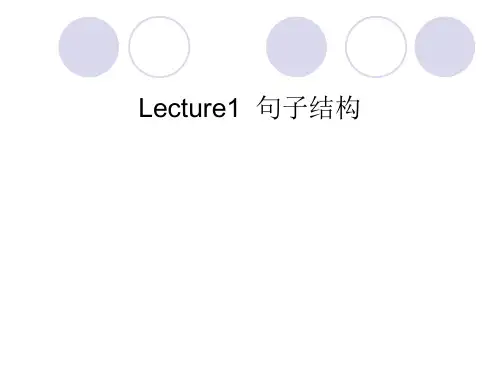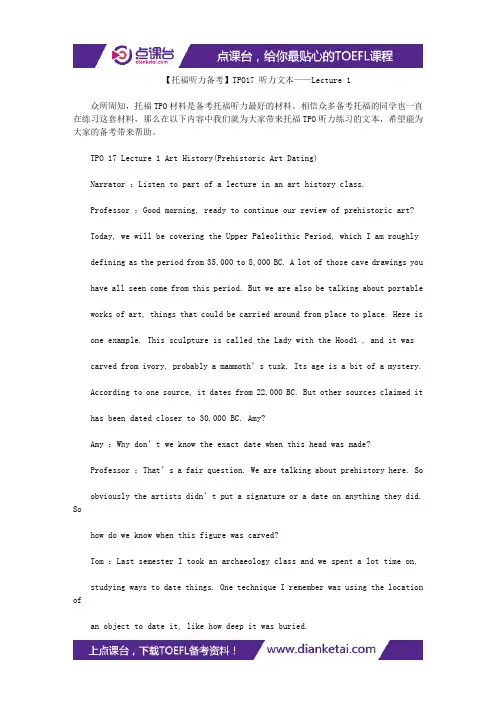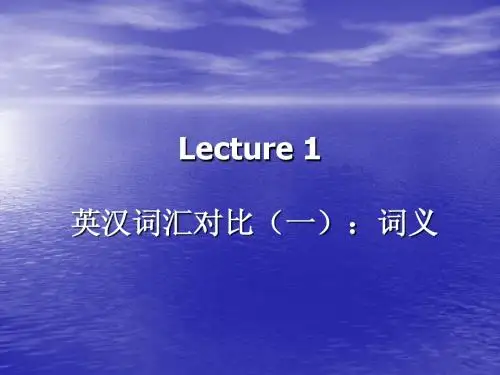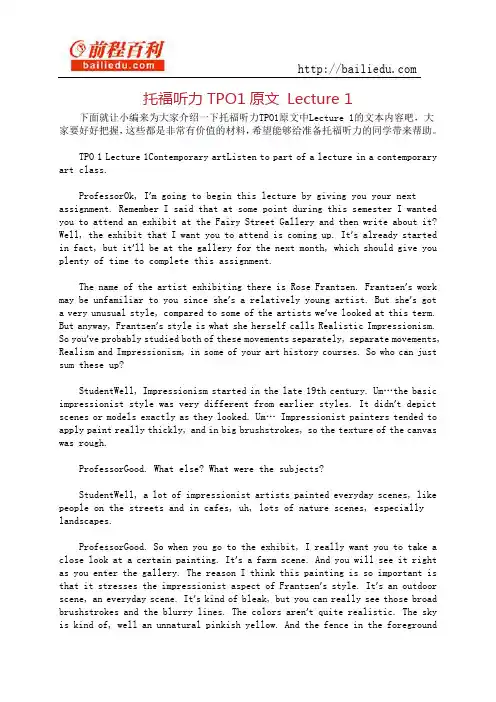Lecture1
- 格式:pdf
- 大小:568.58 KB
- 文档页数:30



托福听力tpo40lecture1、2、3、4原文+题目+答案+译文Lecture1 (2)原文 (2)题目 (4)答案 (5)译文 (6)Lecture2 (7)原文 (7)题目 (9)答案 (11)译文 (11)Lecture3 (13)原文 (13)题目 (16)答案 (18)译文 (18)Lecture4 (20)原文 (20)题目 (22)答案 (24)译文 (24)Lecture1原文NARRATOR:Listen to part of a lecture in an art history class.MALE PROFESSOR:Last class I passed out your assignment for your first paper,and today I want to spend some time going over it.Mm…most people never take any art history until they get to college,so many of you have probably never written an art history paper before.I gave you a list of appropriate works of art for you to write about.So your next step in this process needs to be to go look at the work you've selected as your topic.And bring a pencil and a notepad with you,because I don't mean you should just drop by at the museum and glance at it so you can say you've seen it in real life.You need to go and sit in front of the work and really look at it—carefully and slowly.And keep careful notes about what you see—you’ll need them for the kind of art history paper you're going to be writing…it's what we call a formal analysis.A formal analysis of a work of art,any kind of art,is based on its formal qualities, which means qualities related to the form—things like color…texture…line…shapes…proportion…and composition.Probably the closest thing to a formal analysis you might have written is for an English class.If you've…say…written an analysis of a poem,you've used the same skills—you've given an analysis of the poem by describing and analyzing its form and meter.A formal analysis paper in art history is very similar.Now,before you begin writing your formal analysis,you'll want to start with a summary of the overall appearance of the work—a brief description of what you see. Are there figures—people?What are they doing?Or is it a landscape…or an abstract representation of something?Tell what the subject is,and what aspects are emphasized in the painting.This will give your reader an overview of what the work looks like before you analyze it.The next part of your paper—the actual formal analysis—will be the longest and most important section of your paper,where you describe and analyze individual design elements.For this portion of the paper,you're going to rely on the notes you took at the museum,because you should be able to describe in detail the design elements the artist uses,and how they are used.For example,does the artist use harsh lines or soft lines—are the colors bright or muted?Focus on the design elements that you feel are most strongly represented in that particular work of art. And if you don't know where to begin,take note of where your eye goes first.Then describe things in the order in which your eye moves around the work.This will help you understand how one part relates to another—the interaction between the different parts of the work.OK,this kind of analysis should occur throughout the main portion of the paper.In the last section of your paper—and this goes beyond formal analysis—you comment on the significance of what you have seen.What details of the work convey meaning?Some significant details will not be apparent to you right away,but if you look long enough,you realize how important they are for your interpretation of the work.Many years ago,I was writing a formal analysis of a painting of a little boy.In the painting,a little boy was standing in his nursery,and he was holding a toy bird in his hand,and there were more toys around him in the background of the painting. Because of the bird he was holding,I assumed at first that the painting was about the innocence of children.But as I looked at the painting longer,I realized that the boy's eyes looked sad even though there was no discernable expression on his face.And then it dawned on me that,even though he was surrounded by toys,he was all alone in his nursery.The boy's eyes were a significant detail in the painting,that I didn't notice at first.题目1.What point does the professor make about the writing of a formal analysis in art history?A.Its objective is to identify common features of several works of art.B.Its most important part is the explanation of an artwork's significance.C.Several styles of writing a formal analysis are used by art historians.D.A particular approach is required to present Information about an artwork.2.According to the professor,what will students need to do before writing the art history paper?A.Look at examples of formal analysis in textbooksB.Take notes on the artwork they will write aboutC.Go to different museums before selecting a topic for the paperD.Study the historical context of the artwork they will write about3.Why does the professor mention an English class?A.To explain the difference between visual language and written languageB.To explain that students need good writing skills for their assignmentC.To point out similarities between a poetry paper and the students'assignmentD.To point out that many art historians become writers4.What does the professor recommend as a way to understand the relationship between different parts of an artwork?A.Looking for lines that connect different parts of the workB.Examining the artwork from several different anglesC.Looking for similar colors the artist used throughout the workD.Determining how the viewer's eyes move around the work5.Why does the professor talk about his own experience analyzing the painting of a little boy?A.To point out a common misconception about formal analysisB.To stress the importance of looking at an artwork thoroughlyC.To show why a formal analysis should not emphasize small detailsD.To provide an example of an artwork that is easy to analyze6.The professor describes three sections the art history paper should contain.Place them in the order in which they should appear in the paper.Click on a phrase.Then drag it to the space where it belongs.A.Analysis of the design elements the artist usesB.Discussion of the meaning of the artworkC.Summary of the appearance of the artwork答案D B C D B CAB译文旁白:下面听一段艺术史课程的片段。



【托福听力备考】TPO17 听力文本——Lecture 1众所周知,托福TPO材料是备考托福听力最好的材料。
相信众多备考托福的同学也一直在练习这套材料,那么在以下内容中我们就为大家带来托福TPO听力练习的文本,希望能为大家的备考带来帮助。
TPO 17 Lecture 1 Art History(Prehistoric Art Dating)Narrator :Listen to part of a lecture in an art history class.Professor :Good morning, ready to continue our review of prehistoric art?Today, we will be covering the Upper Paleolithic Period, which I am roughlydefining as the period from 35,000 to 8,000 BC. A lot of those cave drawings youhave all seen come from this period. But we are also be talking about portableworks of art, things that could be carried around from place to place. Here isone example. This sculpture is called the Lady with the Hood1 , and it wascarved from ivory, probably a mammoth’s tusk. Its age is a bit of a mystery.According to one source, it dates from 22,000 BC. But other sources claimed ithas been dated closer to 30,000 BC. Amy?Amy :Why don’t we know the exact date when this head was made?Professor :That’s a fair question. We are talking about prehistory here. Soobviously the artists didn’t put a signature or a date on anything they did. Sohow do we know when this figure was carved?Tom :Last semester I took an archaeology class and we spent a lot time on,studying ways to date things. One technique I remember was using the location ofan object to date it, like how deep it was buried.Professor :That would be Stratigraphy. Stratigraphy is used for dating portable art. When archaeologists are digging at a site, they make very careful notes about which stratum(strata), which layer of earth they find things in. And, you know, the general rule is that the oldest layers are at the lowest level. But this only works if the site hasn’t been touched, and the layers are intact. A problem with this dating method is that an object could have been carried around, used for several generations before it was discarded. So it might be much older than the layer or even the site where it was found. The stratification technique gives us the minimum age of an object, which isn’t necessarilly its true age. Tom, in your archaeology class, did you talk about radiocarbon dating?Tom :Yeah, we did. That had to do with chemical analysis, something to do with measuring the amount of radiocarbon that’s left in organic stuff. Because we know how fast radiocarbon decays, we can figure out the age of the organic material.Professor :The key word there is organic. Is art made of organicmaterial?Tom :Well, you said the lady with the hood was carved out of ivory. That ’s organic.Professor :Absolutely. Any other examples?Amy :Well, when they did those cave drawings. Didn’t they use, like chacoalor maybe colors, dyes made from plants?Professor :Fortunately, they did, at least some of the time. So it turns outthat radiocarbon dating works for a lot of prehistoric art. But again there’s aproblem. This technique destroys what it analyzes, so you have to chip off bits of the object for testing. Obviously we are reluctant to do that in some cases.And apart from that, there’s another problems. The date tells you the age of thematerial, say, a bone or a tree, the object is made from, but not the date when the artist actually created it. So, with radiocarbon dating, we get the maximum possible age for the object, but it could be younger.Ok, let’ s say our scientific analysis has produced an age range. Can we narrow it down?Amy :Could we look for similar styles or motives? You know, try to find things common to one time period.Professor :We do that all the time. And when we see similarities in pieces of art, we assume some connection in time or place. But is it possible that we could be imposing our own values on that analysis?Tom :I am sorry. I don’t get your point.Professor :Well, we have all kinds of pre-conceived ideas about how artistic styles develop. For example, a lot of people think the presence of details demonstrates that the work was done by a more sophisticated artist. While a lack of detail suggests a primitive style. But trends in art in the last century orso certainly challenge that idea. Don’t get me wrong though, analyzing the styles of prehistoric art can help dating them. But we need to be careful with the idea that artistic development occurs in a straight line, from simple to complex representations.Amy :What you are saying is, I mean, I get the feeling that this is like a legal process, like building a legal case, the more pieces of evidence we have, the closer we get to the truth.Professor :Great analogy. And now you can see why we don’t have an exact date for our sculpture, the lady with the hood.。



托福听力TPO1原文Lecture 1下面就让小编来为大家介绍一下托福听力TPO1原文中Lecture 1的文本内容吧,大家要好好把握,这些都是非常有价值的材料,希望能够给准备托福听力的同学带来帮助。
TPO 1 Lecture 1Contemporary artListen to part of a lecture in a contemporary art class.ProfessorOk, I’m going to begin this lecture by giving you your next assignment. Remember I said that at some point during this semester I wanted you to attend an exhibit at the Fairy Street Gallery and then write about it? Well, the exhibit that I want you to attend is coming up. It’s already started in fact, but it’ll be at the gallery for the next month, which should give you plenty of time to complete this assignment.The name of the artist exhibiting there is Rose Frantzen. Frantzen’s work may be unfamiliar to you since she’s a relatively young artist. But she’s got a very unusual style, compared to some of the artists we’ve looked at this term. But anyway, Frantzen’s style is what she herself calls Realistic Impressionism. So you’ve probably studied both of these movements separately, separate movements, Realism and Impressionism, in some of your art history courses. So who can just sum these up?StudentWell, Impressionism started in the late 19th century. Um…the basic impressionist style was very different from earlier styles. It didn’t depict scenes or models exactly as they looked. Um… Impressionist painters tended to apply paint really thickly, and in big brushstrokes, so the texture of the canvas was rough.ProfessorGood. What else? What were the subjects?StudentWell, a lot of impressionist artists painted everyday scenes, like people on the streets and in cafes, uh, lots of nature scenes, especially landscapes.ProfessorGood. So when you go to the exhibit, I really want you to take a close look at a certain painting. It’s a farm scene. And you will see it right as you enter the gallery. The reason I think this painting is so important is that it stresses the impressionist aspect of Frantzen’s style. It’s an outdoor scene, an everyday scene. It’s kind of bleak, but you can really see those broad brushstrokes and the blurry lines. The colors aren’t quite realistic. The sky is kind of, well an unnatural pinkish yellow. And the fence in the foregroundis blue, but somehow the overall scene gives an impression of a cold, bleak winter day on a farm. So that’s the impressionist side of her work.Oh, and speaking about farms, that reminds me. One interesting thing I read about Franzten is that when she first moved back to Iowa after living abroad, she often visited this place in her town called the Sales Barn. And the Sales Barn, it was basically this place where the local farmers bought and sold their cattle, their farm animals. And the reason Frantzen went there, and she later on would visit other places like dance halls, was to observe people and the ways that they moved. She really found that this helped her work---that it gave her an understanding of body movements and actions, how humans move, and stand still, what their postures were like, too.So, what about Realism? What are the elements of Realism we should be looking for in Frantzen’s work?StudentUm… real honest depictions of subject matter, pretty unidealized stuff, and pretty everyday subject matter, too.ProfessorGood. One other painting I really want you to look at is of a young woman surrounded by pumpkins. You will notice that the woman’s face is so realistic looking that it’s almost like a photograph. The woman’s nose is a little less than perfect and her hair is kind of messed up. This is realism. But then, the background of the painting, this woman with the pumpkins is wrapped in a blanket of broad thick brushstrokes, and, it’s all kinds of zigzagging brushstrokes and lines, kind of chaotic almost when you look at it close. And there are vibrant colors. There’s lots of orange, with little hints of an electric blue peeking out.I find Frantzen to be a very accessible artist. I mean, some artists, to appreciate them, you have to know their life story. But here’s a little bit about Rose Frantzen’s life anyway. She attended art school, but was told by one of her instructors that she was not good at illustration, that she should go into advertising instead. So she took advertising classes and fine arts classes too, until she was convinced by the head of an advertising agency that her work was really good, that she could be an artist. But of course, it’s not as easy as that, and so Frantzen had to paint other people’s portraits at places like art fairs just to make money to buy paint for her more serious art work. No matter what, she never stopped painting. And now, Frantzen is doing extremely well. And her work is being shown all over the country. So I think most of us would be discouraged if we had to face challenges and difficulties like that. But what’s important is that you keep at it that you don’t give up. That’s what is really important to remember.《当代艺术》独白:听一段节选自当代艺术课堂的讲座。


托福听力tpo41lecture1、2、3、4原文+题目+答案+译文Lecture1 (2)原文 (2)题目 (4)答案 (5)译文 (6)Lecture2 (7)原文 (7)题目 (9)答案 (11)译文 (12)Lecture3 (13)原文 (13)题目 (16)答案 (18)译文 (18)Lecture4 (20)原文 (20)题目 (22)答案 (24)译文 (24)Lecture1原文FEMALE PROFESSOR:Many organisms have developed the ability to survive in harsh environmental conditions—extreme heat or cold,or,very dry conditions....Like, plants in the desert—your textbook doesn’t have much about the specifics on desert plants,but I think that desert plants are great examples of specialized adaptations to extreme environmental conditions.So with desert plants,there are basically three different adaptive strategies.And I should point out that these strategies are not specific to any particular species—many different species have developed each of the adaptations.So,first off,there are succulent plants.There are many different species of succulent plants,but they all can absorb and store a lot of water.Obviously,opportunities to get water in the desert are few and far between.Generally,rains are light and short,so the rain doesn’t seep too far down into the soil…and there's a limited window of time for any plant to get the water before it evaporates.But succulent plants have a spread-out and shallow root system that can quickly pull in water from the top inch of soil,though the soil has to be saturated,since succulents aren't good at absorbing water from soil that’s only a little moist.Succulent plants also are well suited to retaining water—important in an environment where rainy days are rare.Succulent plants can store water in their leaves,in their stems,or in their roots.And to keep that moisture from evaporating in the hot desert sun,most succulent plants have a waxy outer layer that makes them almost waterproof when their stomates are closed.They also preserve water by minimizing their surface area—the more of the plantthat’s out in the sun,the more potential there is to lose stored-up water—and that means that most succulent plants have few,if any,leaves.Now besides succulent plants,there are also drought-tolerant plants. Drought-tolerant plants are like bears in a way.You know how bears mostly sleep through the winter?They can survive without eating because their metabolism slows down.Well,drought-tolerant plants also go into a dormant state when resources—in their case,water—runs short.A drought-tolerant plant can actually dry out without dying.I said before that most desert rains are light and brief,but occasionally there's a heavy one.Drought-tolerant plants revive after one of these significant rainfalls—and they're able to absorb a good bit of the rainfall due to their deep roots.Actually the root system for drought-tolerant plants is more extensive than the root systems of many plants that live in wetter climates.Drought-tolerant plants can even absorb water from relatively dry soil because of their deep roots,in contrast to succulent plants.The third adaptive strategy is to avoid the drought conditions altogether.Yes,there are plants that do this—annual plants.An annual plant will mature and produce seeds in a single season that will become the next generation of annual plants.In desert conditions,annual plants grow in the fall or spring to avoid the heat of summer and the cold of winter.Of course,these plants could face a serious problem if a particular fall or spring happened to be very dry—they would have difficulty growing and could die before producing seeds.But they have a mechanism to prevent one year of low rainfall from wiping them out. Not all seeds an annual plant puts out will grow the following year.Some seeds remain dormant in the ground for several years.It's a type of insurance that protects the annual plants from a season of poor growing conditions,of unfavorable weather.题目1.What is the lecture mainly about?A.The growth rates of plants in different geographical regionsB.Different ways that plants have adapted to desert environmentsC.The different mechanisms that plant roots use to absorb waterD.Different kinds of succulent plants2.What are two features of succulent plants that help them survive in deserts?[Click on2answers.]A.Succulent plants store water in their leaves and stems.B.Succulent plants become dormant until the next rainfall.C.Succulent plants have short stems.D.Succulent plants have few leaves.3.Why does the professor mention bears?A.To remind students of information from a previous lectureB.To point out a feature common to all desert plantsC.To reinforce a point about drought-tolerant plantsD.To help students understand the concept of adaptation4.What is one ability that drought-tolerant plants have that succulent plants do not have?A.The ability to absorb water from dry soilB.The ability to absorb water through their leavesC.The ability to prevent moisture from being lost through their leavesD.The ability to shed leaves5.Why can annual plants grow in a desert even after a year of no rainfall?A.Annual plants have an extensive root system that can absorb water from far away.B.Annual plants produce seeds all year long.C.Seeds of annual plants can store water for a long time.D.Seeds of annual plants can survive in the ground for a long time without water.5.Listen again to part of the lecture.Then,answer the question.(PROFESSOR)The third adaptive strategy is to avoid the drought conditions altogether.Yes,there are plants that do this.Why does the professor say this: (PROFESSOR)Yes,there are plants that do this.A.To correct a previous statementB.To acknowledge a potentially surprising factC.To anticipate the types of questions that students might have about the topicD.To make sure that students are paying attention答案B ADC AD B译文教授:许多生物已经发展了在恶劣环境中生存的能力:酷热、严寒,或者非常干燥的环境。
智 课 网 托 福 备 考 资 料托福听力TPO5学习笔记之lecture1-智课教育旗下智课教育以下是小编的托福听力TPO5学习笔记中关于lecture1的内容,针对难词注解、长难句分析以及考题对应考点这三大方面展开,仅供参考。
下面就让小编来为大家介绍一下这篇托福听力TPO5学习笔记的相关内容吧,这是小编的一些见解,以便帮助大家更加充分的理解TPO真题,希望能够给正在准备托福听力的考友们带来帮助。
一、难词注解Alligator n. 短吻鳄(产于美国及中国);短吻鳄皮革;鳄口式工具adj.鳄鱼般的;鳄鱼皮革的;鳄鱼皮纹的vi. 皱裂;裂开sewer n. 下水道;阴沟;裁缝师vt.为…铺设污水管道;用下水道排除…的污水vi. 清洗污水管twinkle n. 闪烁vt. 使闪耀;闪耀vi. 闪烁;发亮Meme 模因transmission n. 传动装置,[机] 变速器;传递;传送;播送Replicators n. [遗] 复制基因;重复符Fecundity n. [生物] 繁殖力;多产;肥沃mutation n. [遗] 突变;变化;转变二、长难句分析the whole point of defining this familiar process as transmission of memes is so that we can explore its analogy with the transmission of genes.将这种人们熟悉的过程定义为模因的传递的重点在于我们能够可以将它与基因的传递相类比。
难句类型:介词短语做定语,so that 句式难句拆分:the whole point of+介词短语,so that+句子三、考题对应考点6.A meme is defined as a piece of information copied from person to person. By this definition, most of what you know,ideas, skills, stories, songs are memes. All the words you know, all the scientific theories you’ve learned, the rules your parents taught you to observe, all are memes that have been passed on from person to person. 开头原则中的背景引入式,讲座开头举出两个例子,都是为了今天讲课的主题—meme,而memes that have been passed on from person to person,对应B选项7. "Well we’ve all heard this song. Where am I going with this? Well, both the song and the story are examples of memes"举例原则,当教授介绍完这两个例子之后,说了前面这句话,both the song and the story are examples of memes,所以答案选择C8.在教授介绍完meme的含义之后,说“By this definition, most of what you know, ideas, skills, stories, songs are memes. All the words you know, all the scientific theories you’ve learned, the rules your parents taught you to observe, all are memes”,By this definition看出是强调原则,所以答案是AD9. 教授之前举了一个alligator的例子,之后又提到"If you takethe alligator story, it can exist for a long time in individual memory, let’s say, my memory".说明她记住这个 alligatorstory很多年,所以选择B10. Fecundity is the ability to reproduce in large numbers. For example, the common housefly reproduces by laying several thousand eggs, so each fly gene gets copied thousands of times. Memes, well, they can be reproduced in large numbers as well. How many times have you sung the‘twinkle, twinkle song’ to someone? Each time you replicated that song, and maybe passed it along to someone who did not know it yet, a small child maybe.举例原则,For example,前后两个例子互相对比,所以选择D11.Other memes are replicated with higher fidelity though, like the twinkle, twinkle song. It had the exact same words 20 years ago as it does now. Well, that’s because we see songs as something that has to be performed accurately each time. If you change a word, the others will usually bring you in line. They’llsay, ‘that’s not how you sing it’, right?,结尾原则,当别人说错的是后你会改正,课件人们在传播时不会改变太多。
托福听力tpo43lecture1、2、3、4原文+题目+答案+译文Lecture1 (2)原文 (2)题目 (4)答案 (6)译文 (6)Lecture2 (7)原文 (7)题目 (10)答案 (12)译文 (12)Lecture3 (14)原文 (14)题目 (16)答案 (18)译文 (19)Lecture4 (20)原文 (20)题目 (22)答案 (24)译文 (25)Lecture1原文NARRATOR:Listen to part of a lecture in a botany class.FEMALE PROFESSOR:It's autumn,and as you know,in most parts of the United States the leaves on the trees are changing color from green…to yellow,orange,and lots of other colors.So this'll be a great time to talk about how and why some of these leaves turn one color in particular—and that's bright red.Well,before we discuss why leaves turn red,first let's,um—look,I know this is very old material,but just to play it safe—let's first go over why leaves are usually green.It’s chlorophyll, right?Leaves get their green color from chlorophyll—the chemical that's responsible for photosynthesis.The chlorophyll in the leaves collects energy from the Sun,in the form of sunlight,and it converts this energy into sugar,which is food for the plant. It's chlorophyll that makes leaves green most of the time.Now,the classic explanation for why leaves change color is this.In autumn,the leaves start preparing for the winter and stop synthesizing new chlorophyll.Since chlorophyll is sensitive to sunlight and to cold temperatures—both of which you get in autumn—the existing chlorophyll in the leaves breaks down.And since it's not being replaced by the new chlorophyll,the green color of the leaves gradually fades away.As this happens,the other pigments present in the leaf become visible.According to the classic theory,this is true for the red pigment as well.It was there in the leaf all along but it was hidden by the green chlorophyll.OK, so that's the classic explanation,and it's partially right.Why do I say“partially”?Well,it's probably true for pigments like yellow or orange,but it doesn't seem to hold for the red pigment.Let's back up a bit.Just what produces this red color in leaves?It's a red pigment called anthocyanin.Here's where the classic explanation doesn't seem to apply to red.What's interestingis that during the summer,there was very little if any anthocyanin in the leaves,but in the weeks before a tree is about to drop its leaves,the production of anthocyanins increases significantly.In other words,unlike those other pigments,anthocyanins are not just unmasked by the breakdown of chlorophyll in autumn;they're actually created at this time.So that raises a question.Why would a tree produce more anthocyanin just before dropping its leaves?Why does the tree spend so much of its resources doing this just before the leaves fall off?On the surface,this doesn't make sense.It'd be like spending money to,I don't know,to have your old car repainted when you know the car's not going to last more than a couple of months.All this extra anthocyanin in the autumn seems like a waste.But remember,nature is very economical with its resources,so that means anthocyanin must be serving some function that's important for the tree.Today there are some theories about what that function might be.One of them involves predatory insects;another involves fungi.You know,the more I read about these theories and the related research,it always created more questions for me than answers.So I was really glad to learn about a totally different theory…a new one.It seemed to come with research and data that give a full explanation.So here it is.Remember I said the chlorophyll breaks down?Well,in autumn,a whole lot of other chemical constituents of the leaf break down as well.I don't mean they're totally destroyed,'cause actually they break down into other,different chemicals that the tree can reabsorb from the leaves and reuse later.Now,this reabsorption process is very important for the tree,and—here's the key—it's sensitive to light,meaning that too much exposure to sunlight can interfere with this process.So where does anthocyanin fit in here?Well,anthocyanin's more stable than chlorophyll.It's not harmed as easily by the Sun or the cold.So it's still working long after the chlorophyll breaks down.But what doesit do?The theory is that anthocyanin protects the reabsorption process from the sunlight. For example,if you look closely at a red leaf on a tree,you'll notice that most of the red pigment is on the upper side of the leaf,the side facing the Sun.This new theory suggests that what the anthocyanin is doing there on top is shielding the rest of the leaf from the sunlight…and more importantly,allowing those important chemicals to be reabsorbed by the tree.题目1.What is the main purpose of the lecture?A.To explain how the red pigment in leaves breaks downB.To show that leaf color varies based on the tree speciesC.To introduce a theory about why leaves turn a particular colorD.To explain how chlorophyll protects trees in autumn2.What does the professor imply when she explains why leaves are green?A.She wants to correct a common misconception about the topic.B.She thinks the students are probably already familiar with the material.C.She believes the process is too complicated to discuss in depth.D.She knows that students are often confused about the functions of chlorophyll3.What does the professor mean when she says that the classic theory is partially right?A.It describes what happens in the summer but not what happens in autumnB.It describes what happens in tree leaves but not what happens in leaves of other plantsC.It explains how pigments are synthesized but not how they break down.D.It explains some cases of color change in tree leaves but not all cases.4.Why does the professor mention painting a car?A.To question why a large amount of anthocyanin is produced just before leaves fallB.To explain why most leaves turn red instead of other colorsC.To remind students how cooler temperatures affect the color of leavesD.To show how anthocyanin absorbs sunlight to produce food for trees5.The professor mentions theories about why leaves turn red that involve predatory insects and fungi.What is her opinion about those theories?A.They are based on careful research.B.They do not completely explain the phenomenon.C.They have not received enough attention.D.They have been proved to be incorrect.6.According to the professor,why does anthocyanin appear on the upper side of some leaves?A.To help chlorophyll absorb the sunlightB.To maximize the leaf's utilization of sunlightC.To accelerate the breakdown of chlorophyllD.To protect an important process from the sunlight答案C BD A B D译文旁白:请听一部分植物学的讲座。